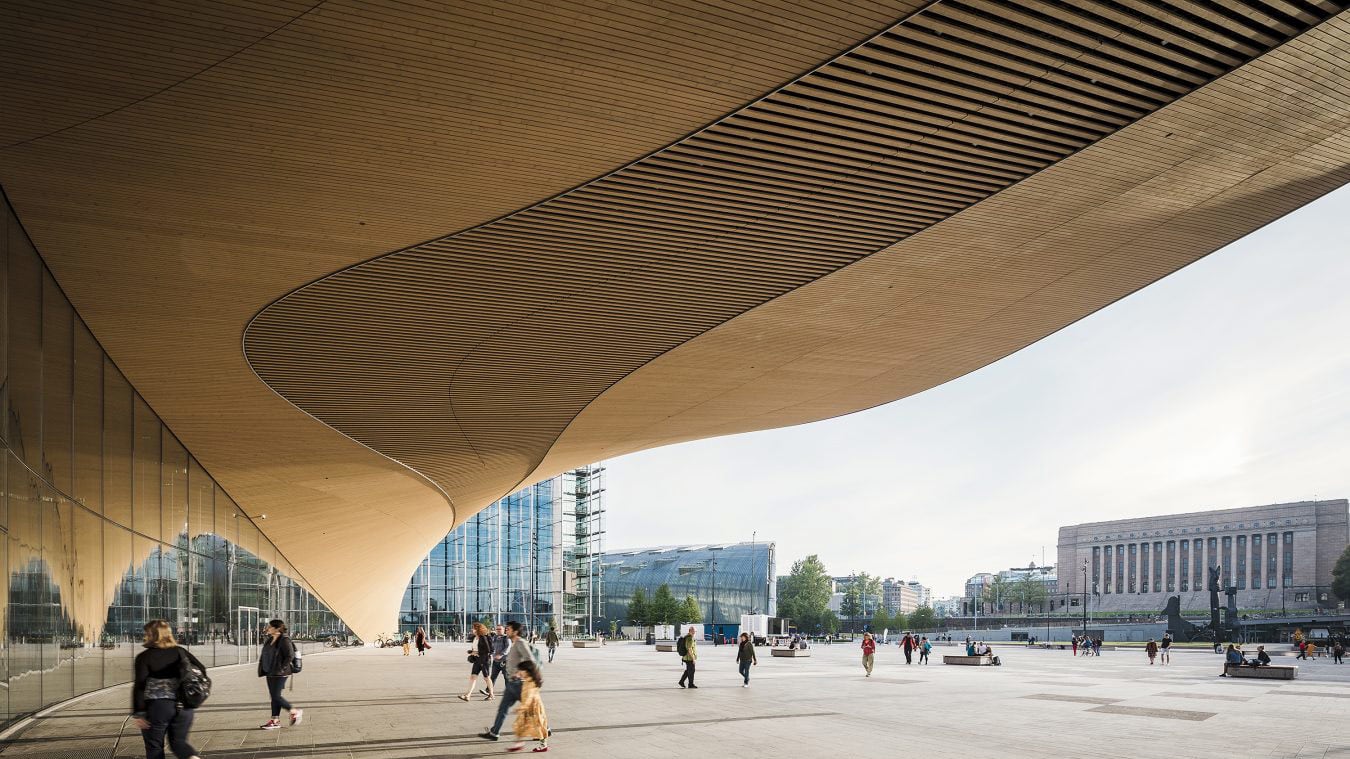I initially went Helsinki’s Oodi Library on a whim. My friend’s son needed another Harry Potter book. And because I find visiting a location in any city I don’t live in inherently interesting, I tagged along. But walking into the boat-like building, and stepping into the airy ground-floor lobby with its high ceilings, cinema, and café, was an exercise in skirting expectations. And this was before I was led up the double-helix staircase to explore the rest of the massive, 10,000 square meter building. Yes, we were here for books, but on a routine family trip, I had inadvertently discovered one of Helsinki’s most forward-thinking buildings, and the latest selection for The Daily Beast’s monthly series, the World’s Most Beautiful Libraries.

Architecture in Helsinki is a fairly well-known term, to the point an Australian band even borrowed the term. Traditionally, the phrase translates to functional, streamlined buildings, largely inspired by the country’s Swedish and Russian neighbors. And, as my friends often remind me—someone who’s barely acclimatized to Southern California rainfall—they’re all well insulated enough to keep residents warm during the Finnish capital’s winter months. But while the functionalism of famed Finnish architect Alvar Aalto may cast a long shadow over the country, as Antti Nousjoki explains, it’s still a developing legacy.
“What we've been trying to do as well for the last 20 years is to kind of make Helsinki and Finland more part of the international architecture scene and make the city more fun and also them to utilize the kind of international contemporary means of construction,” says Nousjoki, a design principle at ALA, the firm responsible for Oodi’s groundbreaking layout. “We’re already old enough that I can clearly see a generation coming after us who's criticizing us for doing landmark buildings [with] distinctive identities… our generation, and our office is definitely known for quite rich, visually strong buildings, utilizing material contrasts and surprising shapes and forms.”

Located in the Töölönlahti district next to Helsinki Music Centre and Kiasma Museum of Contemporary Art, there is a sense that Oodi belongs to this new school of architectural thought. As Nousjoki reveals, the location did play into the overall shape of the wavy structure. But so did dropping preconceived notions of what a building should look like. It was an idea that led to the upper floor balcony that stretched over Kansalaistori square, and the creation of a grand spruce timber façade, a material commonly associated in Finland with household dwellings, here elevated to a focal point. (Nousjoki laughs, admitting that during the December 2018 opening, it was still only partially installed due to ongoing fire safety tests, a detail only the most gimlet-eyed visitors noticed.)
ALA won the bid to create Oodi based on a design submitted during a 2012 contest, where they were asked to reimagine what a library could be, an approach that Nousjoki refers to as creating a cathedral to thinking. What that translated to in practice was to build a “third place,” i.e. somewhere to go that isn’t home or work, and where buying a latte isn’t a requirement for hanging out.

The upper level or “book heaven” is the most analogous with the traditional library concept. Large windows open up the space, preventing it from going gloomy in the winter when the city receives less than six hours of daylight. Nine living trees complete the pseudo-greenhouse atmosphere, flanking a row of bubble chairs, designed and popularized by the Finnish designer, Eero Aarnio. Keeping in line with Helsinki’s reputation as a tech-friendly city, there’s even three retrieval robots to assist with the 100,000-volume collection in Finnish, English, and Swedish. At one point, there was even a “social robot,” complete with googly eyes, who could guide readers to a particular section—a pilot program Oodi hopes to bring back at some point in the post-pandemic era.
But if the top floor in all its bookworm glory is a tribute to the power of the written word, the building’s second floor is a temple of the power of putting knowledge to action. The level houses a series of steel and wood-lined specialty rooms, visitors can investigate or hone almost any skill, noisy or quiet, thanks to the library’s army of soldering stations, laser cutters, handicraft tools, sewing machines, computers, gaming stations, and vinyl printers. Need an industrial kitchen for cooking or an immersive meeting room with smart-glass walls? Yes, you can book that too. The city of Helsinki poured €100 million into creating a space that democratizes creativity—and on the second floor of Oodi there’s a delicious sense of potential that comes with no one being left behind due to lack of funds. My friends, members of a local band, proudly revealed they’ve been making trips to Oodi to record since the library’s gear is more advanced than what they have at home.

Well, there is a slight caveat—most endeavors are possible at Oodi. While warblers and belters will be pleased to know that Karaoke, one of Finland’s favorite pastimes, is possible at Oodi, early reports the building would house a sauna proved to be untrue. Although Nousjoki notes that despite there being more saunas per capita in Helsinki, there are surprisingly few public facilities in that district, and if Oodi ever decides to mix knowledge with steam the building is already equipped with the needed hookups.
“That was in the early brief,” he says. “It was one of [the librarian’s] attention-grabbing slides in a presentation that said there will be a sauna.”
Ultimately, ALA and Helsinki’s wild reimagining of what a library is capable of hasn’t gone unnoticed. Oodi has received a series of industry awards, including recently being awarded the grand prize in DETAIL magazine’s biennial architecture competition. And in an era of social distancing and limited services, architecture fans can still visit online.
As it continues to gain attention, the building has also become a calling card for ALA. In addition to a series of international bids, the design firm is currently working on revamping Helsinki’s Vantaa Airport terminal two, expanding the footprint by 45 percent, and allowing them to service over 20 million passengers per year. (Early concept drawings of the project suggest Oodi-reminiscent sloping timber roof lines and green spaces.) As Nousjoki explains, he’s proud to be part of the Finnish architecture community, and hopes that the conversation and ideas surrounding Helsinki’s central library can continue.
“Building things is always a little bit crazy but this was interesting,” says Nousjoki. “What we've tried to do with architecture, that's maybe a little bit more complex and fun and surprising and rich and interesting than it used to be. I think the people are not expecting such a strong and curious spaces. They're, they're used to being provided this safe, average building—something that's so high quality but has little interest, this Finnish way of doing things quite often… One of the things that I felt there, especially among like slightly older people, was a sense of relief that okay, now we have a building of international pedigree. The Finnish safe system can provide something exciting and daring. That’s what Helsinki is becoming now, more confident and more daring.”






